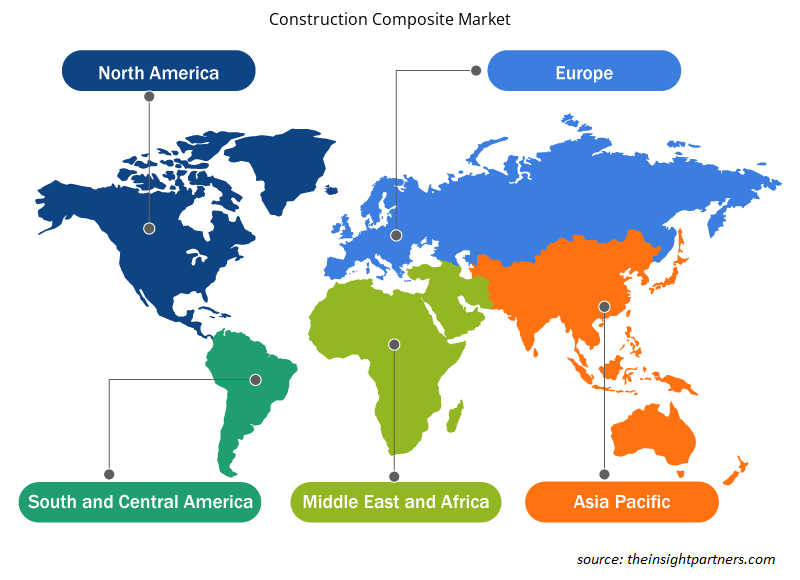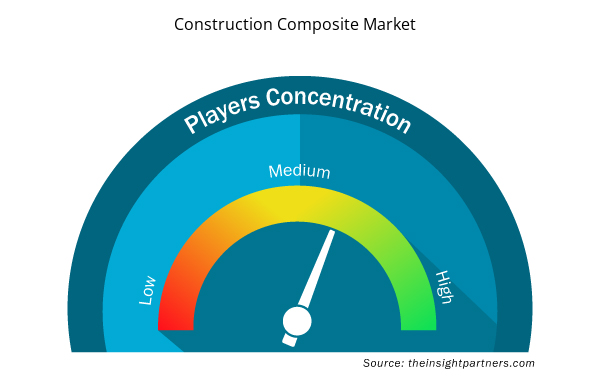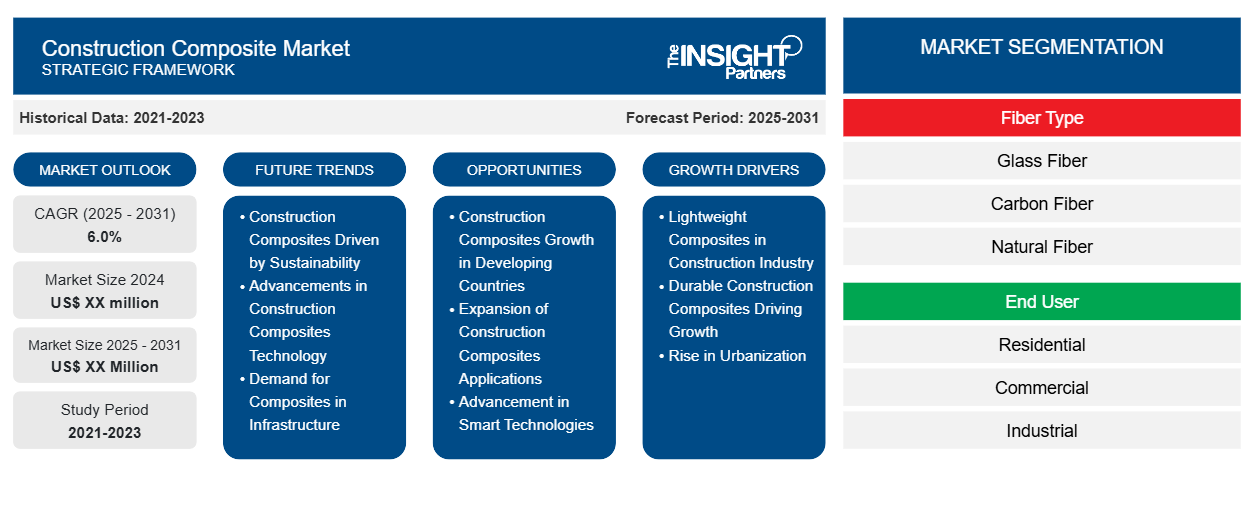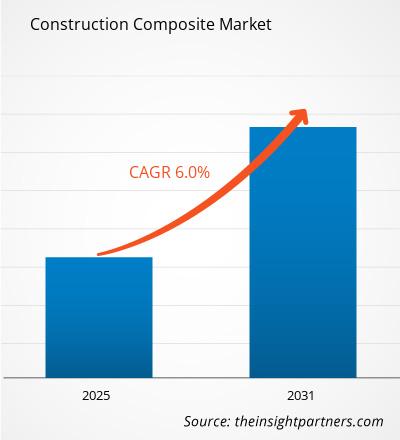Si prevede che il mercato dei materiali compositi per l'edilizia registrerà un CAGR del 6,0% dal 2024 al 2031, con una dimensione di mercato in espansione da XX milioni di dollari nel 2024 a XX milioni di dollari entro il 2031.
Il report è segmentato per tipo di fibra (fibra di vetro, fibra di carbonio, fibra naturale, altri). Il report è anche segmentato per utente finale (residenziale, commerciale, industriale, infrastruttura civile e altri). L'ambito del report copre 5 regioni: Nord America, Europa, Asia Pacifico, Medio Oriente e Africa, Sud e Centro America e paesi chiave in ogni regione. L'analisi globale è ulteriormente suddivisa a livello regionale e nei principali paesi. Il report offre il valore in USD per l'analisi e i segmenti di cui sopra.
Scopo del rapporto
Il report Construction Composites Market di The Insight Partners mira a descrivere il panorama attuale e la crescita futura, i principali fattori trainanti, le sfide e le opportunità. Ciò fornirà spunti a vari stakeholder aziendali, come:
- Fornitori/produttori di tecnologia: per comprendere le dinamiche di mercato in evoluzione e conoscere le potenziali opportunità di crescita, consentendo loro di prendere decisioni strategiche informate.
- Investitori: condurre un'analisi completa delle tendenze in merito al tasso di crescita del mercato, alle proiezioni finanziarie del mercato e alle opportunità esistenti lungo la catena del valore.
- Enti di regolamentazione: regolamentano le politiche e le attività di controllo sul mercato allo scopo di ridurre al minimo gli abusi, preservare la fiducia degli investitori e sostenere l'integrità e la stabilità del mercato.
Segmentazione del mercato dei materiali compositi per l'edilizia
Tipo di fibra
- Fibra di vetro
- Fibra di carbonio
- Fibra naturale
Utente finale
- Residenziale
- Commerciale
- Industriale
- Infrastruttura civile
Personalizza questo report in base alle tue esigenze
Riceverai la personalizzazione gratuita di qualsiasi report, comprese parti di questo report, o analisi a livello nazionale, pacchetto dati Excel, oltre a usufruire di grandi offerte e sconti per start-up e università
- Scopri le principali tendenze di mercato in questo rapporto.Questo campione GRATUITO includerà analisi di dati che spaziano dalle tendenze di mercato alle stime e alle previsioni.
Fattori trainanti della crescita del mercato dei materiali compositi per l'edilizia
- Compositi leggeri nel settore delle costruzioni: c'è una crescente domanda di materiali leggeri che migliorerebbero le prestazioni strutturali delle costruzioni e ridurrebbero anche i costi di trasporto e consegna nel settore delle costruzioni. I compositi, compresi i compositi a matrice polimerica, hanno elevati rapporti resistenza/peso, rendendoli adatti a molte applicazioni. Tale domanda incoraggia l'innovazione e l'uso dei compositi, il che si traduce in risultati migliori in qualsiasi attività di costruzione.
- I materiali compositi per l'edilizia durevoli stimolano la crescita: è risaputo che i materiali compositi per l'edilizia sono resistenti alla corrosione e all'umidità. Questa qualità aiuta a ridurre la frequenza dei lavori di manutenzione. Di conseguenza, sono economici per i costruttori. Poiché l'attenzione del settore si sposta verso materiali durevoli, la popolarità dei materiali compositi rimane in costante aumento nel mercato dei materiali compositi.
- Aumento dell'urbanizzazione: il fenomeno globale dell'urbanizzazione avviene a un ritmo molto rapido e pertanto si presenteranno molte opportunità al mercato dei compositi da costruzione. La costruzione di città e l'avvio di più attività infrastrutturali comporta elevati requisiti per nuovi materiali da costruzione che saranno sufficienti per i metodi di costruzione contemporanei e i criteri di prestazione emessi. I compositi coprono la resistenza e l'adattabilità richieste per tale espansione.
Tendenze future del mercato dei compositi per l'edilizia
- Materiali compositi per l'edilizia guidati dalla sostenibilità: il mercato dei materiali compositi per l'edilizia sta mostrando una propensione verso materiali sostenibili. Sempre più costruttori stanno optando per risorse riciclate o riutilizzabili per costruire i loro edifici, considerando che il mondo intero sta lavorando per la sostenibilità. Questo cambiamento riduce il danno arrecato all'ambiente grazie alle tecniche di costruzione impiegate, nonché alle elevate voglie di strategie di edilizia ecologica da parte dei consumatori.
- Progressi nella tecnologia dei compositi da costruzione: i cambiamenti nelle tecniche di produzione, come l'uso della moderna tecnologia dei polimeri rinforzati con fibre, stanno cambiando il panorama dei compositi da costruzione. Queste nuove tecnologie migliorano le proprietà dei compositi, come il loro peso e le capacità di resistenza all'acqua. Con il passare del tempo, la tecnologia offre la speranza per una costruzione più efficiente e materiali compositi più complessi.
- Domanda di compositi nelle infrastrutture: il mondo sta vivendo una rapida crescita economica a causa di molti, se non tutti, i paesi, in particolare quelli in via di sviluppo, che stanno espandendo le loro infrastrutture. I compositi per l'edilizia godono di una domanda elevata a causa delle priorità governative in materia di trasporti, alloggi adeguati e spesa per lavori pubblici, creando un mercato per materiali ad alta struttura ma leggeri. I compositi sono in grado di soddisfare i requisiti complessi degli attuali progetti infrastrutturali e quindi aumentare la loro domanda sul mercato.
Opportunità di mercato dei materiali compositi per l'edilizia
- Crescita dei compositi per l'edilizia nei paesi in via di sviluppo: il mercato non è limitato a questi paesi; il mercato dei compositi per l'edilizia presenta ampie prospettive nei paesi in via di sviluppo, dove la migrazione urbana e la costruzione di infrastrutture sono al culmine. Man mano che queste aree si rivolgono ad approcci edilizi modernizzati, la necessità di prodotti ingegnerizzati avanzati come i compositi che siano leggeri e altamente durevoli crescerà, consentendo ai produttori di raggiungere clienti diversi e aumentare la loro quota di mercato.
- Espansione delle applicazioni dei compositi da costruzione: i compositi da costruzione stanno gradualmente guadagnando consensi anche in settori diversi da quelli convenzionali. Le innovazioni ne stanno consentendo l'uso in settori quali recinzioni, scale e ringhiere. Questa diversificazione consente ai produttori di penetrare in nuovi mercati e migliorare la propria linea di prodotti per includere una gamma più ampia di applicazioni edilizie.
- Avanzamento nelle tecnologie intelligenti: l'avanzamento delle tecnologie intelligenti nell'edilizia crea un'ottima finestra nel mercato dei compositi. Man mano che gli edifici diventano più avanzati nella tecnologia, c'è una recente necessità di compositi che possano integrare sistemi intelligenti come sensori o sistemi a risparmio energetico. Questa tendenza incoraggia la creatività e l'ideazione di materiali compositi specializzati per l'edilizia per l'edilizia intelligente.
Approfondimenti regionali sul mercato dei materiali compositi per l'edilizia
Le tendenze regionali e i fattori che influenzano il Construction Composite Market durante il periodo di previsione sono stati ampiamente spiegati dagli analisti di Insight Partners. Questa sezione discute anche i segmenti e la geografia del Construction Composite Market in Nord America, Europa, Asia Pacifico, Medio Oriente e Africa, e Sud e Centro America.

- Ottieni i dati specifici regionali per il mercato dei materiali compositi per l'edilizia
Ambito del rapporto sul mercato dei materiali compositi per l'edilizia
| Attributo del report | Dettagli |
|---|---|
| Dimensioni del mercato nel 2024 | XX milioni di dollari USA |
| Dimensioni del mercato entro il 2031 | XX milioni di dollari USA |
| CAGR globale (2024 - 2031) | 6,0% |
| Dati storici | 2021-2023 |
| Periodo di previsione | 2025-2031 |
| Segmenti coperti | Per tipo di fibra
|
| Regioni e Paesi coperti | America del Nord
|
| Leader di mercato e profili aziendali chiave |
|
Densità dei player del mercato dei materiali compositi per l'edilizia: comprendere il suo impatto sulle dinamiche aziendali
Il mercato dei compositi da costruzione sta crescendo rapidamente, spinto dalla crescente domanda degli utenti finali dovuta a fattori quali l'evoluzione delle preferenze dei consumatori, i progressi tecnologici e una maggiore consapevolezza dei vantaggi del prodotto. Con l'aumento della domanda, le aziende stanno ampliando le loro offerte, innovando per soddisfare le esigenze dei consumatori e capitalizzando sulle tendenze emergenti, il che alimenta ulteriormente la crescita del mercato.
La densità degli operatori di mercato si riferisce alla distribuzione di aziende o società che operano in un particolare mercato o settore. Indica quanti concorrenti (operatori di mercato) sono presenti in un dato spazio di mercato in relazione alle sue dimensioni o al valore di mercato totale.
Le principali aziende che operano nel mercato dei materiali compositi per l'edilizia sono:
- CORPORAZIONE STRONGWELL
- Società a responsabilità limitata
- PLASTICA RINFORZATA BEDFORD
- FRATELLI HUGHES INC.
- INTERNAZIONALE SCHOECK
Disclaimer : le aziende elencate sopra non sono classificate secondo un ordine particolare.

- Ottieni una panoramica dei principali attori del mercato dei materiali compositi per l'edilizia
Punti di forza chiave
- Copertura completa: il rapporto esamina in modo completo i prodotti, i servizi, le tipologie e gli utenti finali del mercato dei materiali compositi per l'edilizia, offrendo una panoramica olistica.
- Analisi degli esperti: il rapporto è compilato sulla base della conoscenza approfondita di esperti e analisti del settore.
- Informazioni aggiornate: il rapporto garantisce la pertinenza aziendale grazie alla copertura di informazioni recenti e tendenze nei dati.
- Opzioni di personalizzazione: questo report può essere personalizzato per soddisfare le esigenze specifiche del cliente e adattarsi in modo appropriato alle strategie aziendali.
Il rapporto di ricerca sul mercato dei compositi da costruzione può quindi aiutare a guidare il percorso di decodificazione e comprensione dello scenario del settore e delle prospettive di crescita. Sebbene possano esserci alcune preoccupazioni valide, i vantaggi complessivi di questo rapporto tendono a superare gli svantaggi.
- Analisi storica (2 anni), anno base, previsione (7 anni) con CAGR
- Analisi PEST e SWOT
- Valore/volume delle dimensioni del mercato - Globale, regionale, nazionale
- Industria e panorama competitivo
- Set di dati Excel


- Health Economics and Outcome Research (HEOR) Services Market
- Dealer Management System Market
- Biopharmaceutical Tubing Market
- Latent TB Detection Market
- Vertical Farming Crops Market
- Military Rubber Tracks Market
- Automotive Fabric Market
- Water Pipeline Leak Detection System Market
- Precast Concrete Market
- Electronic Shelf Label Market

Report Coverage
Revenue forecast, Company Analysis, Industry landscape, Growth factors, and Trends

Segment Covered
This text is related
to segments covered.

Regional Scope
North America, Europe, Asia Pacific, Middle East & Africa, South & Central America

Country Scope
This text is related
to country scope.
Domande frequenti
Based on geography, Asia Pacific is expected to register the fastest CAGR from 2023 to 2031.
The report can be delivered in PDF/Word format, we can also share excel data sheet based on request.
Expansion into emerging markets is one of the key opportunities for the market growth.
Strongwell Corporation, Exel Composites, Trex Company Inc, UPM Biocomposites, Bedford Reinforced Plastics, Hughes Brothers Inc, Diversified Structural Composites, Schoeck International, and Advanced Environmental Recycling Technologies Inc are among the leading players operating in the construction composites market.
Rising demand for lightweight materials is driving the market growth
The Construction Composites Market is estimated to witness a CAGR of 6.0% from 2023 to 2031
Trends and growth analysis reports related to Chemicals and Materials : READ MORE..
The List of Companies
1. STRONGWELL CORPORATION
2. TREX COMPANY INC.
3. BEDFORD REINFORCED PLASTICS
4. HUGHES BROTHERS INC
5. SCHOECK INTERNATIONAL
6. DIVERSIFIED STRUCTURAL COMPOSITES
7. UPM BIOCOMPOSITES
8. EXCEL COMPOSITES
9. PULTRON COMPOSITES
10. FIBERGRATE COMPOSITE STRUCTURE, INC.
The Insight Partners performs research in 4 major stages: Data Collection & Secondary Research, Primary Research, Data Analysis and Data Triangulation & Final Review.
- Data Collection and Secondary Research:
As a market research and consulting firm operating from a decade, we have published and advised several client across the globe. First step for any study will start with an assessment of currently available data and insights from existing reports. Further, historical and current market information is collected from Investor Presentations, Annual Reports, SEC Filings, etc., and other information related to company’s performance and market positioning are gathered from Paid Databases (Factiva, Hoovers, and Reuters) and various other publications available in public domain.
Several associations trade associates, technical forums, institutes, societies and organization are accessed to gain technical as well as market related insights through their publications such as research papers, blogs and press releases related to the studies are referred to get cues about the market. Further, white papers, journals, magazines, and other news articles published in last 3 years are scrutinized and analyzed to understand the current market trends.
- Primary Research:
The primarily interview analysis comprise of data obtained from industry participants interview and answers to survey questions gathered by in-house primary team.
For primary research, interviews are conducted with industry experts/CEOs/Marketing Managers/VPs/Subject Matter Experts from both demand and supply side to get a 360-degree view of the market. The primary team conducts several interviews based on the complexity of the markets to understand the various market trends and dynamics which makes research more credible and precise.
A typical research interview fulfils the following functions:
- Provides first-hand information on the market size, market trends, growth trends, competitive landscape, and outlook
- Validates and strengthens in-house secondary research findings
- Develops the analysis team’s expertise and market understanding
Primary research involves email interactions and telephone interviews for each market, category, segment, and sub-segment across geographies. The participants who typically take part in such a process include, but are not limited to:
- Industry participants: VPs, business development managers, market intelligence managers and national sales managers
- Outside experts: Valuation experts, research analysts and key opinion leaders specializing in the electronics and semiconductor industry.
Below is the breakup of our primary respondents by company, designation, and region:

Once we receive the confirmation from primary research sources or primary respondents, we finalize the base year market estimation and forecast the data as per the macroeconomic and microeconomic factors assessed during data collection.
- Data Analysis:
Once data is validated through both secondary as well as primary respondents, we finalize the market estimations by hypothesis formulation and factor analysis at regional and country level.
- Macro-Economic Factor Analysis:
We analyse macroeconomic indicators such the gross domestic product (GDP), increase in the demand for goods and services across industries, technological advancement, regional economic growth, governmental policies, the influence of COVID-19, PEST analysis, and other aspects. This analysis aids in setting benchmarks for various nations/regions and approximating market splits. Additionally, the general trend of the aforementioned components aid in determining the market's development possibilities.
- Country Level Data:
Various factors that are especially aligned to the country are taken into account to determine the market size for a certain area and country, including the presence of vendors, such as headquarters and offices, the country's GDP, demand patterns, and industry growth. To comprehend the market dynamics for the nation, a number of growth variables, inhibitors, application areas, and current market trends are researched. The aforementioned elements aid in determining the country's overall market's growth potential.
- Company Profile:
The “Table of Contents” is formulated by listing and analyzing more than 25 - 30 companies operating in the market ecosystem across geographies. However, we profile only 10 companies as a standard practice in our syndicate reports. These 10 companies comprise leading, emerging, and regional players. Nonetheless, our analysis is not restricted to the 10 listed companies, we also analyze other companies present in the market to develop a holistic view and understand the prevailing trends. The “Company Profiles” section in the report covers key facts, business description, products & services, financial information, SWOT analysis, and key developments. The financial information presented is extracted from the annual reports and official documents of the publicly listed companies. Upon collecting the information for the sections of respective companies, we verify them via various primary sources and then compile the data in respective company profiles. The company level information helps us in deriving the base number as well as in forecasting the market size.
- Developing Base Number:
Aggregation of sales statistics (2020-2022) and macro-economic factor, and other secondary and primary research insights are utilized to arrive at base number and related market shares for 2022. The data gaps are identified in this step and relevant market data is analyzed, collected from paid primary interviews or databases. On finalizing the base year market size, forecasts are developed on the basis of macro-economic, industry and market growth factors and company level analysis.
- Data Triangulation and Final Review:
The market findings and base year market size calculations are validated from supply as well as demand side. Demand side validations are based on macro-economic factor analysis and benchmarks for respective regions and countries. In case of supply side validations, revenues of major companies are estimated (in case not available) based on industry benchmark, approximate number of employees, product portfolio, and primary interviews revenues are gathered. Further revenue from target product/service segment is assessed to avoid overshooting of market statistics. In case of heavy deviations between supply and demand side values, all thes steps are repeated to achieve synchronization.
We follow an iterative model, wherein we share our research findings with Subject Matter Experts (SME’s) and Key Opinion Leaders (KOLs) until consensus view of the market is not formulated – this model negates any drastic deviation in the opinions of experts. Only validated and universally acceptable research findings are quoted in our reports.
We have important check points that we use to validate our research findings – which we call – data triangulation, where we validate the information, we generate from secondary sources with primary interviews and then we re-validate with our internal data bases and Subject matter experts. This comprehensive model enables us to deliver high quality, reliable data in shortest possible time.


 Ottieni un campione gratuito per questo repot
Ottieni un campione gratuito per questo repot